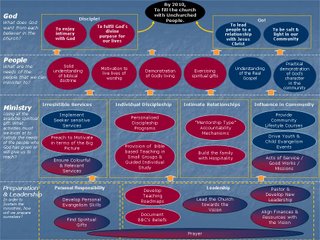Mission
Definition:
The mission describes the organisation’s primary and overarching reason for existence.
Purpose:
The purpose of the mission statement is to keep the focus of the organisation, and is also used to rank and prioritise initiatives.
Working Drafts:
- To win people for Christ and to nurture them to spiritual maturity
- To lead people into a growing relationship with Jesus Christ by creating environments where participants are encouraged and equipped to pursue: 1) Intimacy with God2) Community with insiders3) Influence with outsides
- Growing Christians to change their community and impact the world by helping them to live lives worthy of their calling
- To win friends, family, employees, employers, colleagues, seekers, and people in need for Christ, and to nurture them to spiritual maturity
Final
The PLOT Thickens:
To lead people into a growing relationship with Jesus Christ. To nurture and equip them to pursue:
- Intimacy with God
(Everything that they do and become must flow from an intimate relationship with God) - Influence in the community
(We want people to be outward focussed and to impact their family, friends and colleagues as well as people less fortunate than themselves) - Their divine purpose
(We want people to understand that God has a unique calling for their lives and encourage them to find it and follow it whether it is ministry inside our outside of our church)
Notes:
If this is our mission, then every ministry should ensure that whatever is event, program or activity is held, or whatever teaching is given, does it directly enforce or diliver on the mission.

